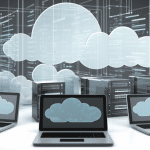It's time to get proactive on the UK's critical national infrastructure (CNI) security -- but where to start?

The critical national infrastructure that underpins the UK has undergone a tremendous amount of digital transformation in recent years. Areas like water treatment, energy and food production are still heavily reliant on operational technology (OT) systems that were often designed and implemented long before the digital revolution.
Digitizing these systems and connecting them to standard IT networks has allowed operators to boost efficiency and bring in practices like remote working and data collection that weren’t possible in an analogue environment.
Software file converters: How they work and why you need them

In today's digital world, we deal with a vast array of file formats daily, from documents and images to videos and audio files. However, not all software or devices can open every document type, leading to compatibility issues. This is where file converter software comes into play, making our digital lives more convenient and efficient.
A file converter is a tool that allows you to convert one format into another. It acts as a digital translator, ensuring that your documents can be opened and used across different platforms, devices, and software applications. Whether you need to convert a Word document to PDF, an image from JPEG to PNG, or a video from AVI to MP4, a file converter software can handle the task seamlessly.
Cloud computing -- The first step to an effective data modernization strategy

Many organizations realize the benefits that lie within the data they collect daily. This modern approach to data empowers businesses to leverage data for innovation and monetization while at the same time enhancing security and privacy. While this may seem like a conundrum as companies have traditionally buried their data deep into IT architecture to prevent it from being accessible, even by the employees, today it is possible to have the best of both. This process starts with the cloud.
The healthcare sector is witnessing a swift surge in cloud adoption. By 2028, it is expected to grow at a Compound Annual Growth Rate (CAGR) of 18.74 percent. This trend of rapid adoption can be seen in the financial services sector too, where organizations are moving to the cloud at an accelerated pace.
Preparing for potential regulations around AI in electronic bill payment and presentment

The speed with which enterprise-level artificial intelligence has moved from the realm of theoretical -- if not outright science fiction -- to a widely adopted business tool has been nothing short of astonishing. The mad dash to find and implement applications for new, AI-based solutions is reminiscent of the rapid ascension of cloud technology in both fervor and consistency: the race to the cutting edge is taking place across industries.
Where sectors differ is in the level of caution they’re bound by their respective norms and requirements to apply in the process. While those in all industries ought to approach new technologies and tools with healthy prudence, in my personal opinion (and I am not an attorney), those of us in the electronic bill payment and presentment (EBPP) space must additionally consider the regulations that govern individuals’ privacy and the security of their data when it comes to something as private as their finances.
What Elon Musk's AI warning says about ethical AI in business

The report by Statista forecasts a significant 21 percent net increase in the United States' GDP by 2030, attributing this growth to the integration of Artificial Intelligence (AI). This projection underscores the immense impact AI is expected to have on economic expansion. However, amid this rapid advancement, tech innovator Elon Musk has expressed serious concerns about the need for AI regulation.
Speaking at the Paris VivaTech event, Musk highlighted the potential dangers of unregulated digital superintelligence. His warnings serve as a vital reminder for businesses to reevaluate their use and engagement with AI technologies, emphasizing the importance of a balanced approach to AI integration in the economic landscape.
The evolving roles of the CIO and CISO [Q&A]

The relationship between an organization's chief information officer (CIO) and chief information security officer (CISO) has traditionally been somewhat at odds, since CIO's job is built around sharing information and the CISO's job is to secure it. Plus, the CIO was normally higher in the organizational hierarchy, which could also cause some tension.
But the relationship has evolved in recent years, to the point where the two positions are often more on par with each other. And with security's growing importance to the business (and the boardroom), the two jobs often share the same goals and responsibilities.
Why cyber risk assessment is critical to staying ahead of threats [Q&A]

The cybersecurity landscape is changing all the time and security teams are constantly searching for anything that can give them an edge in defending their systems.
We spoke to Rajeev Gupta, co-founder and chief product officer at insurance specialist Cowbell Cyber, about cyber risk assessment and how it can help businesses understand their level of risk and improve it to stay ahead of bad actors and threats like phishing attempts.
The way AI is enhancing online security

In an era marked by the relentless expansion of digital connectivity, the assurance of robust online security stands as a critical imperative. Cyber threats, characterized by their growing sophistication and frequency, demand innovative solutions to safeguard sensitive data and preserve privacy.
Among these solutions, artificial intelligence emerges as a transformative force reshaping the landscape of online security. This article delves into the many ways in which AI is revolutionizing online security protocols, from proactive threat detection to dynamic risk assessment and adaptive response strategies.
Businesses call on EU to defend encryption and privacy

In March this year, EU countries' interior ministers are due to vote on the introduction of mandatory client-side scanning for all providers in order to identify child abuse material.
But an open letter, published today, from a group of privacy-focused companies warns of the risk of opening up a backdoor and calls on ministers to defend citizen's right to privacy and strengthen the position of EU companies.
The tension between the CDO and the CISO: The balancing act of data exploitation versus protection

Data is the most valuable resource for the global enterprise. For any company wanting to remain relevant in today’s competitive business landscape, data needs to be at the center of every business decision, allowing the C-suite to review initiatives, make real-time decisions and if necessary reverse actions. A quick response fueled by real data insights will power and improve the customer experience and product offerings while driving lower prices through better efficiency. Ultimately, this will improve the bottom line and deliver successful outcomes for many organizations.
However, to unlock the true value of data, it is equally important that organizations ensure that confidential data is always secure. To achieve this, the Chief Information Security Officer (CISO), who acts as the gatekeeper to data to ensure it is compliant and secure, and the Chief Data Officer (CDO), who aims to unlock and exploit data, have different and competing priorities, yet they must be able to work together towards a common goal to achieve the strategic objectives of the organization and deliver great customer and business outcomes. There are significant benefits to be had when these two role holders work together and huge drawbacks when they don’t.
The EU's AI Act: Good regulation, bad regulation or somewhere in between?

History is littered with knee-jerk legislation, enacted with good intentions and often in response to genuine public fear. If you have ever traveled to the USA, you may be familiar with the I-94W Nonimmigrant Visa Waiver form that must be completed before entry. Among a number of questions asked, one is ‘Have you ever been or are you now involved in espionage or sabotage; or in terrorist activities -- Yes or No’. I’m sure many have often wondered whether those actually involved in such activities would be inclined to tick the ‘Yes’ box. This example effectively illustrates the challenges that all regulators and legislators should ask themselves at the outset, namely:
Are we doing this to address the problem or is it just a knee-jerk reaction to placate journalists and voters? (Remember that line from BBC political comedy Yes Minister -- “He’s suffering from Politician’s Logic. Something must be done, this is something, therefore we must do it.”)
What is fat finger error and how to prevent it

Whoever said "To err is human" was right (actually, it was the English poet, Alexander Pope). Just like in our private lives, we all make mistakes in business too, no matter how diligent or professional we are. The trouble is, some human errors, however small, can have disastrous consequences. Like the fat-finger error that can cost an organization millions.
A fat finger error is a keyboard input mistake that results in the wrong information being transmitted. The term originated in financial trading markets and is now used more broadly in the security industry to describe data breaches that are caused by human error, particularly when the breach is attributed to mistyped information, like an email address.
Kubernetes monitoring: 5 essential strategies for DevOps success

Monitoring Kubernetes clusters is a critical aspect of managing cloud-native applications. Kubernetes, a favored tool among giants like Spotify and Major League Baseball, empowers developers to create and operate at scale. However, the complexity of Kubernetes with its multitude of nodes and containers demands a robust monitoring strategy.
In this article, we share five key practices to enhance your Kubernetes monitoring approach. Let's dive in...
What to look out for when it comes to cybersecurity regulations in 2024

It’s been another busy year for cybersecurity regulations. We saw a new National Cybersecurity Strategy by the White House in March, and throughout the year, we’ve seen the National Cybersecurity Center (NCSC) launch several new initiatives to increase cyber resilience.
As mentioned by Joseph Carson, Chief Security Scientist & Advisory CISO at Delinea, the landscape of cybersecurity compliance is expected to "evolve significantly, driven by emerging technologies, evolving threat landscapes, and changing regulatory frameworks."
Navigating the transition to Microsoft 365… just in time for Copilot

With the rollout of Copilot this fall, businesses everywhere are considering moving to Microsoft 365 to reap the benefits of its AI companion function in supporting business operations.
The first step in tackling this transition is for IT teams and Managed Service Providers (MSPs) to understand the new software, evaluate their existing systems and prepare for the intricate migration that lies ahead.
© 1998-2025 BetaNews, Inc. All Rights Reserved. About Us - Privacy Policy - Cookie Policy - Sitemap.